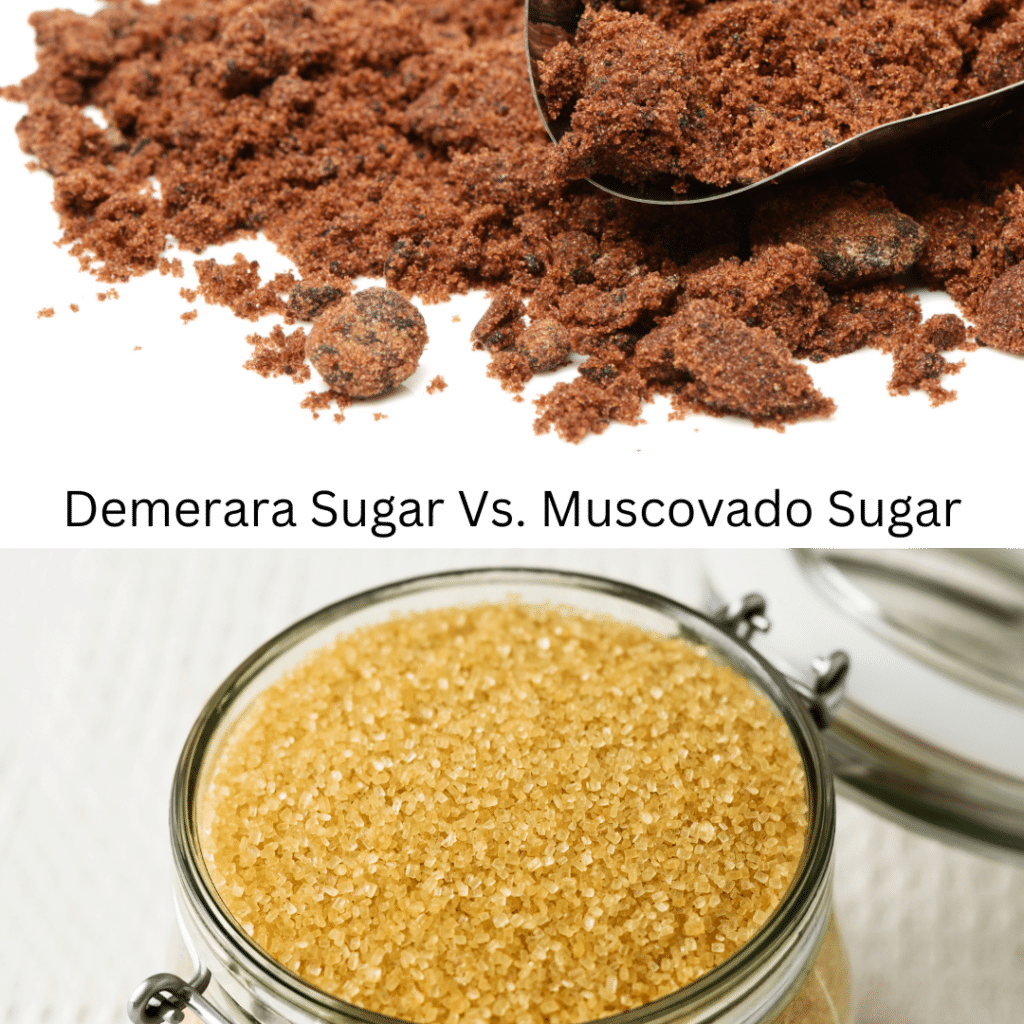In this post, I will compare Demerara Sugar Vs. Muscovado Sugar, and help you understand all the differences that exist between them, similarities, substitutes, and any other important thing you should know about them.
Muscovado sugar is unrefined sugar pressed from sugar cane. The main difference between demerara and muscovado sugar lies in their moisture content. It has more moisture and holds up together with minimal chances of crumbling and flowing freely. It features a slight caramel flavor and is available in dark brown and light brown colors.

Muscovado Sugar
Demerara has large crystals, which means it holds little to no moisture and flows freely. It features a deep and earthy flavor and is available in yellowish-brown color. While these two are types of brown sugars, muscovado has a higher percentage of molasses than demerara and therefore has a richer flavor.

Demerara Sugar
Contents
Differences Between Demerara Sugar and Muscovado Sugar
| Demerara sugar | Muscovado sugar |
| It is low in moisture content and flows freely since it does not clump | It is moister and holds together in clumps; thus does not flow freely |
| It features a deep earthy flavor as it has less molasses content | It features a caramel flavor since it has more molasses |
| It’s available in yellowish-brown color | It is available internationally in a dark brown color and light brown color in some parts of the world. |
| Has a lighter color and larger coarse and dry crystals | Very dark brown and has sticky, soft, and fine crystals |
| May absorb moisture and clump up if left open | Tends to dry out if not stored in an airtight container |
| Contains one to two percent of molasses distribution and is, therefore less flavorful | Contains eight to ten percent molasses distribution and thus has more flavor |
When to Use Demerara Sugar and When to Use Muscovado Sugar
While these two are types of raw brown sugars, they both serve different purposes but can be substituted in some instances.
If a recipe calls for muscovado sugar and it’s not readily available, you can substitute with 200 grams of refined sugar and add 3 tablespoons of molasses for a dark version of muscovado sugar. For a lighter version, substitute with a cup of refined sugar mixed with a tablespoon of molasses
Since muscovado sugar is high in molasses and moisture, it’s ideal for recipes that require a caramel or toffee flavor and a sticky texture. It’s also largely used in preparing brownies, marinades, smoky BBQ sauce, flapjacks, and cookies.
On the other hand, demerara has less molasses content, is dryer, and has larger crystals than muscovado. Since its grains are large and crunch, it’s best used as a topping on baked goods rather than a mix-in since it’s difficult to dissolve.
It’s large crystals lend a sugary toffee-like flavor if added to liquids and warm beverages. It’s especially best if added to tea and coffee as a sweetener or sprinkled as a topping to baked goods like cookies and cakes for a crunchy and sweet outcome.
Demerara Sugar vs. Muscovado Sugar, Can One Substitute One for the Other?
Demerara sugar is not as moist as muscovado sugar, but it is a decent substitute. You can also use refined sugar mixed with molasses to come up with either type of light or dark muscovado sugar.
Though it’s technically possible to substitute these two sugars, there might be specific reasons why a recipe may need a specific type of brown, sugar-whether because it requires a crunchy punch or a rich toffee-caramel flavor.
In general, it’s essential to consider the differences between the sugars in order to substitute accordingly.
Conclusion
Both Muscovado sugar and demerara sugar are types of raw brown sugars processed from sugarcane. Muscovado should be high in moisture and molasses content.
Basically, demerara is the same as muscovado but has been centrifuged to low levels of molasses. And while demerara has large and coarse crystals, muscovado has relatively soft, fine crystals and sticky consistency.
Read more on our blog:

2 thoughts on “Demerara Sugar Vs. Muscovado Sugar”